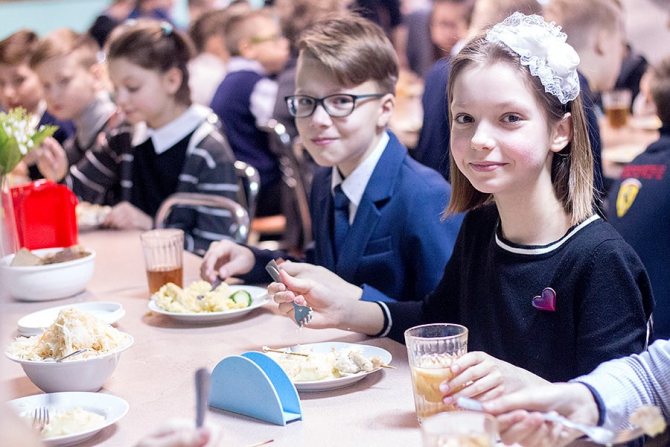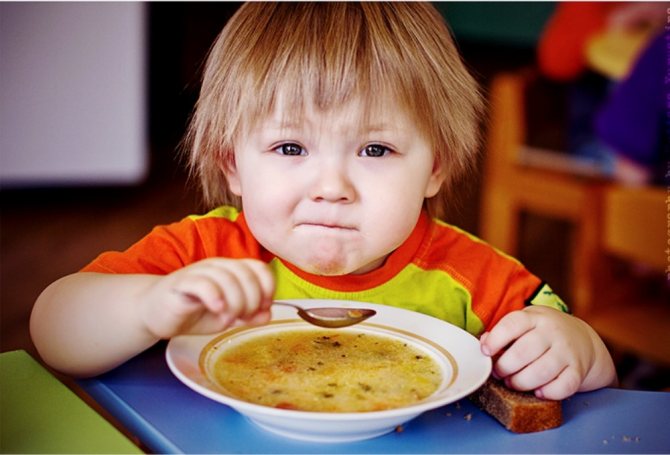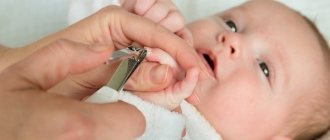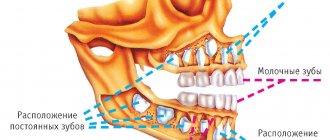When and how to start learning table etiquette?
Carelessness while eating, using your own clothes instead of a napkin is a very unpleasant picture. And, of course, no parent wants their child to have such habits. Therefore, teaching the rules of etiquette at the table is a task that must be approached as early as possible. From about the first year of life. At this age you can give him a spoon in his hand. The parents will still feed him, but by copying your actions, he will quickly learn to eat on his own.
You should not trust theories like “it is useful for young children to play with food, for example, spreading pasty food on the table or plate with their hands.” The authors of such theories claim that this has a beneficial effect on the development of a child’s fine motor skills. Firstly, there is no scientific evidence for this, and secondly, the use of cutlery really has a positive effect on coordination of movements and fine motor skills, in particular.
The main thing in teaching a child is personal example. He, like a sponge, will absorb new knowledge and learn faster.
Basic principles:
- Provide regular reminders about table manners.
- Use books and cartoons to show children how to wash their hands, how to use utensils, etc. A picture before your eyes and your favorite characters will help you quickly learn proper manners. Also have tea parties with dolls and soft toys. This way, children themselves will learn to set the table, communicate with guests, and behave well when they eat.
- Instill all rules by personal example.
- Never shout or scold children at the table, especially in front of guests or at a holiday dinner. If the baby did something wrong, then he needs to be told about it at home.
- Parents should show patience and care for the baby. After regular lessons and explanations, already at the age of 5 he will know all the basic rules of table etiquette.
- Don't forget about hygiene. From an early age, you need to teach your child to be neat at the table and, if necessary, to use napkins.
- Small children love to stuff as large pieces as possible into their mouths. We need to wean them from this ugly habit. And start, for example, with bread: break the bread into small pieces before eating. This also applies to food portions; it’s better to just report it later.
- The ability to ask at the table rather than reach out should also be developed from a very early age. To do this, treats or other food should be beautifully decorated and placed away from the baby (in the form of roses or leaves). Having seen the “yummy” he likes, the child, realizing that he cannot reach it, will begin to ask for it.
We teach the child the rules of good manners. Etiquette and table manners
The topic of etiquette in raising a child should be given great attention, because every parent wants his beloved child to grow up not only as an educated and intellectual person, but also as a cultured person who knows how to behave correctly, beautifully and intelligently in any environment.
A large role in the formation of good manners must be given to the rules of behavior at the table. After all, these skills will be useful to your baby at a very early age, when he goes to kindergarten.
Many parents wonder how to properly instill good table manners in their child, at what age should they start doing this, and what methods to use for this. In order to answer all these questions, you need to understand what useful habits do you first of all want to cultivate in your child? If you want your baby to easily distinguish a meat fork from a fish fork, or be able to conduct small talk, then, of course, an early age is not suitable for this. And if we are talking about the elementary rules of civilized and beautiful behavior at the table, then you need to start from the moment when you teach your baby to eat on his own. Most often this occurs at the age of one year.
Personal example is the key to quickly and correctly developing etiquette at the table
It is no secret that young children largely copy and adopt the behavior of adults; these could be parents, grandparents or brothers and sisters. Therefore, pay great attention to how you behave at lunch or dinner. It will be easier for a child to understand and learn that talking with his mouth full or slurping, laughing loudly or gesticulating at the table is ugly if he does not see such an example. If your baby sees from birth that you always wash your hands and his hands before eating, that after eating everyone says “thank you,” then in the future he will not even think about behaving any differently.
While your baby eats in a separate high chair, be sure to set his dining table with the necessary utensils, just like an adult table. Use a deep bowl for the first course and a flat plate for the second. After the child has mastered eating with a spoon, gradually teach him to eat the second dish with a fork. To start, you can use a special plastic fork for babies. Then, by the time he enters kindergarten, the child will have mastered the rules of using cutlery well, and will understand that, for example, you can eat a bun or cookies with your hands, but for cutlets or cheesecakes you need a fork.
You can offer a knife for the second course to a child closer to 4-5 years old; this is exactly the age when his hand will be sufficiently formed and prepared to use this device. Perhaps the baby will not yet be able to fully use it when eating, but he will acquire the necessary knowledge and skills.
Don't forget the napkin! This item should always be present during meals. At first, you will wipe his mouth yourself, and closer to 1.5 years, the child will be able to use a napkin himself and will get used to the fact that he needs to eat neatly and cleanly.
Methods for teaching children table manners
Everyone knows that the best way to teach children is through play. And table manners are no exception. Role-playing games are perfect for little ones. Buy a set of toy dishes and throw a dinner party for the bears, dolls and bunnies. At the same time, set the table for your toy guests along with your baby. This will help the baby learn about tableware and its use. Be sure to praise the bears and bunnies for sitting upright and not putting their elbows on the table, and praise the doll for washing her hands before eating and using a napkin correctly. Your baby will definitely take all this into account.
Read poems and proverbs about food and behavioral culture with your child. Look at the pictures. It is very good if you buy or make a poster with your child - a reminder about the rules of eating and hang it in the kitchen.
From the age of 4-5, you can gradually involve your child in setting the table before meals. At this age, all children love to carry out such tasks and are happy to lay out napkins, forks and spoons. You can also trust to put a plate with bread or cold cuts. This attitude towards eating will forever develop in the child the habit of eating not “hastily” and “on the go,” but at a beautifully set table.
What should you avoid when teaching your child good manners?
As with any training, when instilling a culture of eating in a child, there are important points that you should pay attention to and, if possible, avoid their manifestations:
Avoid harsh criticism and dissatisfaction with any manifestations of carelessness. Do not allow a child at any age to play or indulge in food. Even if your baby has a poor appetite, do not allow him to take food into the room, and under no circumstances try to feed him while playing or watching cartoons.
If you show ingenuity, patience, love and respect for your baby, then by kindergarten he will have learned all the necessary table manners. And there will be no protest in it when asked to wash your hands or behave quietly and neatly at the table.
Table etiquette in kindergarten
When a mother tells the teacher that we are a simple family, we do not need the child to understand what all these cutlery and napkins are for, this is wrong. But, unfortunately, teachers often face this position. You should know that food culture and rules of behavior are not a desire to “stand out” to others. This has a simple and clear meaning.

For example:
- You need to wash your hands before eating. This way, germs will not enter the body along with food.
- Using a tablecloth protects food from contact with the table covering.
- The rules of “no naughtiness” and “no chatting” while eating will allow the child to chew food thoroughly and protect him from choking.
- A napkin on your knees will keep your baby's clothes clean.
Table etiquette rules for schoolchildren
Nobody likes it when people slurp at the table. Therefore, before the child goes to school, it is imperative to wean him from this bad habit. To begin with, parents and elders must lead by example. But often, the habit of slurping goes together with the habit of talking while eating - with your mouth full. And over breakfast/lunch/dinner together, the child simply cannot help but express all his thoughts and experiences. In this case, you need to explain over and over again until the child remembers - you need to speak only after all the food has been chewed and swallowed.
Shortly before school, you can teach children to use a knife while eating. More often than not, this innovation goes off with a bang; it even happens that children start eating dishes that they haven’t eaten before. But we must not forget to explain to them the “safety precautions” when using this cutlery.

It would not be amiss to teach him how to act in unusual situations, for example, if a bone or pebble gets into food - you do not need to pull it out of your mouth with your fingers, but carefully spit it out onto a spoon or fork and place it on a napkin or the edge of the plate.
If a school-age child still prefers to reach across the table for the dish he likes rather than ask, you should change your tactics. You need to ask him to hand over something more often - this will either develop the habit of asking or shame him, but both options will lead to the same result.
Basic table manners for children
All rules of table etiquette should be divided into 2 large groups: what can be done at the table and what is strictly prohibited. Let's take a closer look at each.
What can and should be done?
- We always wash our hands before eating, so children also need to be taught this basic rule. Of course, at first the mother helps the baby wash his hands, but from the age of 2-3 years he can do it on his own. At first, parents will have to be reminded of this often, but then this boring rule will become a habit.
- You should only eat at the table. Buy a special high chair for your baby, so he will become a full-fledged participant in every family meal. Older children are already full participants in the meal.
- Before eating, it would be correct to wish those gathered a bon appetit, and after eating, thank your mother or hostess for the delicious food.
- The baby must be careful while eating. It is better to wear a bib for children 1-3 years old. At an older age, children need to be taught to use a napkin.
- If the child is thirsty, he should wipe his lips with a napkin before taking the glass. This way there will be no greasy marks left on the glass.
- You need to eat calmly and not rush anywhere.
- If you want to sneeze, you should turn away from the table and cover your mouth with your hand. You also need to apologize after this.
- You can talk at the table only after the child has chewed and swallowed the food.
- If the desired dish is far from the child, he should ask to pass the dish to him and thank him.

What should be banned?
- You cannot fool around, talk loudly, make noise or wave your arms.
- It is not acceptable to play with food, throw it or smear it on the plate.
- No need to stuff your mouth with food.
- To wipe your mouth, you need to use a napkin, not a sleeve or tablecloth.
- You cannot take food from a neighbor.
- Licking your fingers is also not allowed.
- Today, elbows on the table are no longer a crime; little attention is paid to this. But you still need to teach them not to hurt their neighbors.
General recommendations
In addition to advice for each age stage, there are also general rules, the implementation of which will quickly accustom your child to “table” etiquette. What do experts recommend:
- A child should not be forced to follow the rules of etiquette. It is much healthier and more effective to play with your baby. As noted above, a baby can invite baby dolls and baby dolls to a dinner party, setting the children's table according to all the rules. Mom will only have to monitor the progress of the meal.
- Be sure to enlist the support of your spouse and grandmothers. It's no secret that some adults allow their children to do things that mom or dad forbids. You also need to be consistent when teaching skills. The child should be praised for every success.
- Don't forget to involve your children in preparing dinner. Even a small child is able to set the table: arrange plates, lay out cutlery, put out bread. This will allow the baby to understand the value of products and the importance of the dinner ceremony.
- Don't forget about cartoons and literary works that talk about the principles of etiquette. It is imperative to talk about the scenes you see, especially if they demonstrate unwanted behavior.
Parental example is the lesson that children learn best. If mom or dad behaves carefully at the table, uses cutlery correctly, washes their hands before eating, etc., then mastering the skills will not take long.
Let's go to the cafe
Don’t forget about the ceremonial “eating”. So that in the future children do not fall into a stupor at the sight of starched tablecloths and napkins, solemnly decorated tables and a full set of cutlery, you need to prepare them for this. Regular family dinners (with all the above attributes) and family trips to a restaurant can serve as preparation.

A preschooler may not know which knife to use to cut meat or fish; the main thing is to follow the general rules of etiquette at the table.
Everyone understands that good manners are a necessary thing. This also applies to the rules of behavior at the table. Having studied the information presented, you can easily teach your child all the subtleties of behavior while eating. The only thing, remember, the main thing in the learning process is regularity and personal example. Then your child will easily learn all the rules, and playing tea will reinforce his knowledge. By school age, children should be familiar with all the basic table manners.
Table etiquette for preschoolers. article
Table etiquette for preschoolers.
All the rules of decent behavior have long been known, the only thing that remains is the ability to use them.
B. Pascal
Etiquette rules for children are one of the important topics that parents should raise in their family in a timely manner. A person of any age living in a society must take into account the norms of behavior accepted by this society and follow them. The child’s place in society depends on how conscientiously parents raise their child. Etiquette is a set of norms and rules governing the behavior of people in society or a particular social group. Speaking about etiquette for children, we mean the rules of good behavior, first of all, in relation to adults, because they are the ones who can evaluate behavior as “good” or “bad” due to their experience. Without a doubt, we all love to eat delicious food... However, Not everyone knows the basic rules of table manners. In order not to find yourself in a stupid situation in front of the people with whom you will be at the same dinner table, learn these basic rules and you will never be ashamed of yourself.
So, table manners for children:
• Don't put your elbows on the table: they can disturb your neighbor and take up a lot of space. It is very indecent to rock in a chair.
• Don't talk with your mouth full - chew and swallow, then speak, don't slurp - try to eat silently.
• To make it easier to chew, do not bite off too large pieces.
• Put as much food on your plate as you can eat.
• Meat, served in a large piece, is usually eaten with a fork and knife: the fork in the left hand, the knife in the right. You cut the meat into small pieces, put the knife aside, take the fork in your right hand - and eat for yourself! This manner of eating demonstrates good manners (the plate looks more neat).
• There is no need to eat with a spoon what you can eat with a fork, and also do not use a knife if you can get by with the same fork. For example, fish, cutlets, and aspic are not cut with a knife—small pieces are broken off with a fork.
• Place side dishes (potatoes, vegetables, pasta) on a fork using bread, not your fingers.
• Wipe your hands and lips with napkins, never with your hands, tablecloth, or clothes.
• If you want to try some dish that is far from you, do not reach across the table for it, but ask politely to pass it on.
• From common dishes, serve food not with your spoon or fork, but with those that are on the common dish.
• Sweets such as cakes and pastries are not eaten from the hand, but are broken off with a spoon in a plate.
• And most importantly: you must definitely thank the person who prepared and served your dishes, say the magic “thank you”!
Table manners are very important in the modern world. A festive table, a trip to a cafe or restaurant, a romantic or friendly dinner cannot do without basic rules of etiquette...











